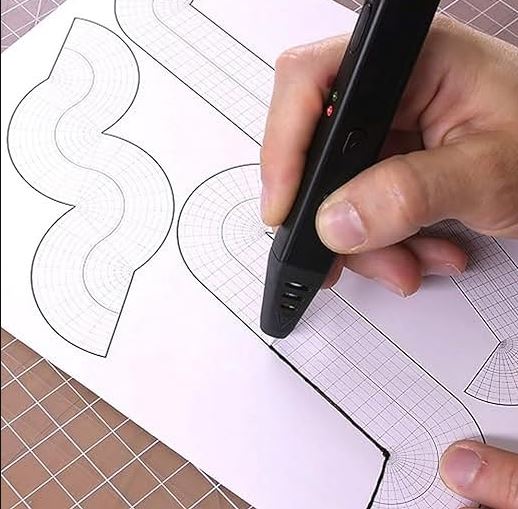The way we think about design and creation has been completely transformed by 3D painting pens. Anyone interested in crafting, from novices to seasoned artists, can now use 3D printing technology thanks to these cutting-edge tools. In essence, a 3D painting pen is a compact, portable 3D printer that allows users to extrude heated plastic in a freehand, drawing-style manner to create three-dimensional objects. Imagine drawing while in midair, with each line almost instantly becoming a solid form. Because these pens give artists and crafters the chance to create intricate, interactive works of art in a completely new way, the creative possibilities are endless.
These pens work pretty simply: you insert a filament (usually PLA or ABS plastic) that has been heated to a certain temperature, and it instantly hardens when it is extruded from the pen’s nozzle. Users can easily draw objects or shapes that maintain their form and strength thanks to this quick hardening process. Some pens give users a great deal of customization by allowing them to change the temperature, speed, and even the type of filament they use. Professionals are not the only ones who can benefit from 3D painting pens; anyone, from inquisitive kids to aspiring designers, can use them effectively.
With a futuristic twist, the 3D painting pen’s versatility is remarkably similar to that of a paintbrush. Nowadays, artists are able to sketch in three dimensions in addition to on paper or canvas. These pens let users express their creativity without being limited by conventional materials, whether they are making sculptures or complex models. Particularly for teaching STEM concepts, the pens are growing in popularity in educational settings. Consider a classroom where students construct models of molecules, planets, or even historical sites using a 3D pen. Deeper learning is promoted and abstract ideas become more tangible through the tactile experience of making three-dimensional objects by hand.

3D painting pens have spurred a surge of innovation in product design and prototyping in addition to their artistic uses. For designers and inventors, the ability to quickly produce unique models for product testing has created new opportunities. For instance, engineers can now swiftly create physical prototypes of new product designs, which improves the efficiency of the iterative creation process. This is especially helpful in fields where accuracy and timeliness are critical. A 3D pen provides a rapid, on-the-fly solution for producing small models, accessories, or parts, whereas traditional 3D printing can be a time-consuming and costly procedure.
Applications of 3D Painting Pens:
| Industry | Application | Benefits |
|---|---|---|
| Education | Science models, historical landmarks, interactive learning tools | Hands-on learning, visualizing complex concepts |
| Art & Design | Sculptures, wearable art, prototypes | Unrestricted creativity, quick prototyping |
| Prototyping | Product mockups, small parts design | Faster iteration, cost-effective prototypes |
| Fashion | Fashion accessories, jewelry design | Customizable, unique designs, creative expression |
| Technology & Engineering | Functional models, test prototypes | Quick prototyping, low-cost experimentation |
A wide variety of filament types are now available as a result of these pens’ increasing popularity. The range of textures, colors, and durability that different materials provide greatly expands the creative possibilities. Because PLA is made from renewable resources, it is especially well-liked for its smooth finish, ease of use, and environmental advantages. Conversely, ABS is preferred due to its strength and flexibility, which makes it ideal for industrial or more functional applications. The introduction of metallic, glow-in-the-dark, and even wood-based filaments gives the creative process a new dimension of excitement and novelty.
The ability of 3D painting pens to facilitate learning and teaching is one of their most notable qualities. Children can use the pen because of its easy-to-understand operation, while professionals can use it because of the more sophisticated models’ customizable features. For example, educational institutions have started using these pens in their curricula to encourage students to be creative and solve problems. Using a 3D pen’s tactile properties promotes active participation and aids students in real-time visualization of theoretical ideas.
Key Benefits of 3D Painting Pens:
| Feature | Benefits |
|---|---|
| Portable and Easy to Use | Immediate creativity, no need for complex setup |
| Variety of Filament Options | Ability to experiment with textures, colors, and finishes |
| Affordable for Beginners | Entry-level pricing, accessible for all skill levels |
| Enhances Learning and Creativity | Engages tactile learners, visualizes complex ideas |
| Applications Across Industries | Suitable for art, prototyping, education, design |
The advantages of 3D pens for product creation are being leveraged by sectors such as fashion and design in addition to education. While architects and engineers use these pens to design prototypes, designers are experimenting with using them to create intricate details on apparel and accessories. In sectors that demand precise details and fast turnaround times, the capacity to quickly develop models and test designs creates new avenues for innovation.
More sophisticated models have features that will appeal to professional artists and designers, even though many of the 3D painting pens on the market are made with beginners in mind. These pens give users more control over the extrusion process, enabling them to precisely create intricate details. Moreover, the inclusion of temperature control and speed adjustments guarantees that users can customize the pen to meet their unique requirements, whether they are making intricate patterns or substantial constructions.